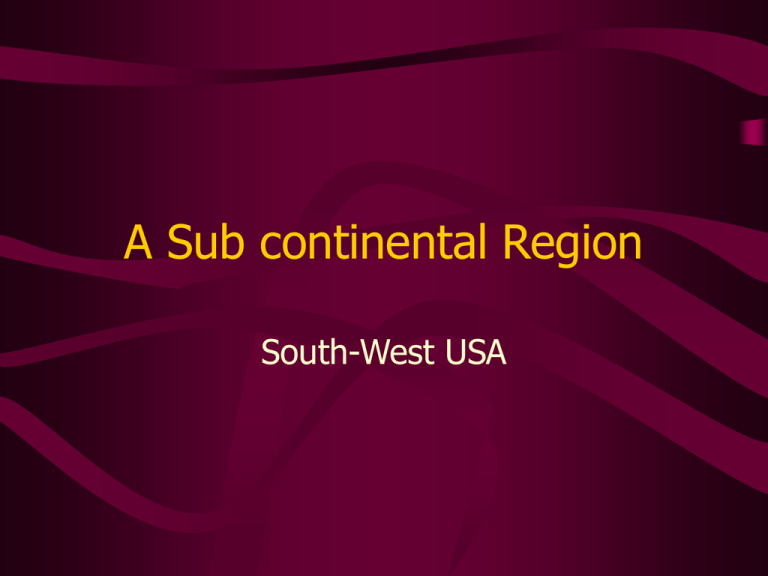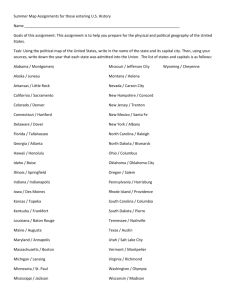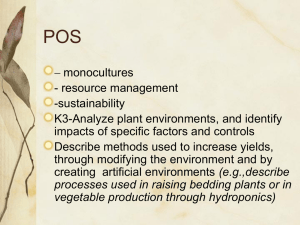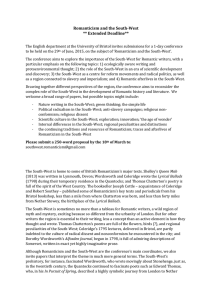File
advertisement

A Sub continental Region South-West USA Notice of Use Restrictions Certain materials in this presentation are included under the Fair Use exemption of the U.S. Copyright Law and/or under the Fair Dealing exemption of the Ireland Copyright and Related Rights Act, 2000 Materials are included in accordance with the [U.S.] multimedia fair use guidelines; and Materials are restricted from further use. © EDMAN YOST, J. (1999), Copyright Chaos - An Educator's Guide to Copyright Law and “Fair Use”, Intel Teach to the Future CD South-West USA South-West USA • • • • • California to Texas 3000km Specific types of economic development The information technology industry The aerospace industry The oil industry American South-West American South-West • Summary of the South-West: – The South-West is a region of arid plains and Spanish forts, the atmosphere of the ‘old West’, oil and cattle, a ‘can-do’ culture, big money and brash cities Physical Processes • Variety of landscape and topography • California: The Coastal Range, Central Valley and Sierra Nevada • East of Sierra Nevada: intermontane basin and plateaus of the Nevada • The Great Basin of Nevada is the largest basin of inland drainage in the USA Physical Processes • The Rocky Mountains (difficult for 19th century Europeans to cross) • The Texas plains take the traveller through Texas and finally to the Gulf of Mexico The Colorado River • • • • • Main drainage channel Reddish colour of its silt Colorado means ‘coloured’ in Spanish Before dams were built laden with silt Locals claimed that its waters were too thick to drink and too thin to plough • Spring floods and Summer droughts The Colorado River • Dams built to control the flow of water • 20th century • Essential source of water for the people of SW USA • 22million people in California, Nevada and Arizona depend on the river The Colorado River • Irrigation for 400,000 ha in USA and 20,000 ha in Mexico • Lake Mead, behind the Hoover Dam is a major tourist attraction The Colorado River • Ecology of the region is affected by the large dams • Silt that fed the river delta is now accumulating in reservoirs • The delta at the mouth of the river is longer growing • Nutrients supplied by sediments are no longer deposited in the Gulf of California, decline of fish stocks The River Delta A Delta:A river delta is a landform that is formed at the mouth of a river, where the river flows into an ocean, sea, estuary, lake, or reservoir. Deltas are formed from the deposition of the sediment carried by the river as the flow leaves the mouth of the river. Over long periods of time, this deposition builds the characteristic geographic pattern of a river delta. Landscape Climate Climate • Much is arid or semi-arid (low precip) • Much of the region precipitation below 250mm • Southern California, Arizona and New Mexico arid or semi-arid • Death Valley highest daytime temperature of the western hemisphere in Southern California Climate • Mountains have a huge influence on temperature and precipitation • Sierra Nevada has snow-capped peaks in N. California • Mountains, distance from the sea and local winds modify the temperature of the region • Most of the region in the Sun Belt 2500 hours of sunshine per year (Similar to S. Italy) Economic Processes Primary Activities Primary Activities • Major differences in agriculture • Due to climate, soil differences, local markets and availability of water for irrigation • Family farms still important • Agri-companies taking over • Agricultural practices in the region among the most modern in the world Primary Activities • • • • Industry is market focused Fully industrialised Ultra-modern machinery and technology Cattle ranchers use helicopters to survey their herds • Rice farmers in California use laser technology to level fields for irrigation Primary Activities • Ranching: – Occupies a large portion of the agricultural land of the region – Suited to semi-arid regions that are too dry for cereals – Small groups of workers who retain the ‘cowboy’ skills of the past – Cattle stocking rates are lo because of sparse vegetation Ranching http://www.youtube.com/watch?v=jzE97WxxAz8 Primary Activities • Ranching is known as extensive farming • Low output per hectare high output per worker • Cattle born and reared in western range lands and later sold fort fattening to feedlots of California, Texas and the Corn Belt further east • Vast feedlots dot the agri landscape Feedlots • • • • Agri companies Can afford technology required Intensive cattle fattening Migrants from Mexico supply most of the agri labour today Irrigated Agriculture • Central Valley California, Gila Valley Arizona and the Gulf coast of Mexico have intensive agriculture • Requires irrigation • Citrus fruits, vegetables and salad crops (high value crops) for urban market • Rice grown on 2000km2 of heavily irrigated land in Caifornia Pivot Irrigation Agriculture • Irrigation is responsible for the boom in agriculture • Also for the rapidly rising population of recent decades • Irrigation has turned vast deserts into oases of green (vast quantities of perishable foods) • Texas has highest rainfall (great agri state) • Apart from cattle the state produces maize, wheat and Soya beans









